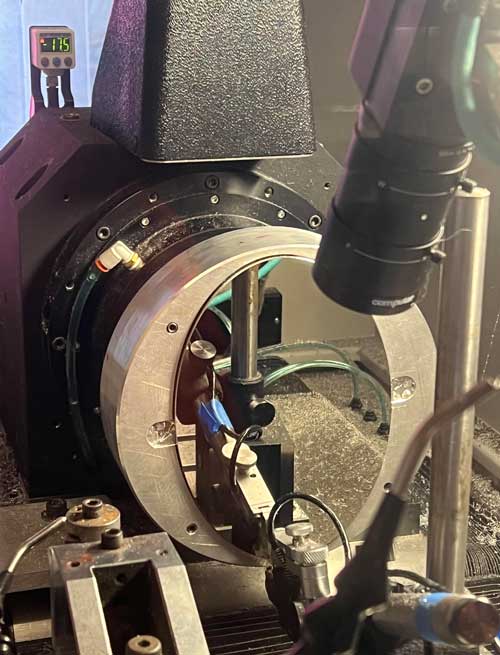Origins of Single Point Diamond Turning and Machining
Diamond turning, or single point diamond turning as it is sometimes known, was originally a term for turning mirror-quality surfaces on high-precision, air bearing lathes using an ultra sharp natural diamond cutting tool. The technique was developed largely in American nuclear weapons laboratories, where components having extremely demanding tolerances of fit, form, and finish were required. Over time the technology was adapted by optics manufacturers, who could produce metal optics having difficult aspheric prescriptions.
Diamond Turning Methods
Over time, several approaches to machining evolved. At the core of each is the fundamental accuracy of the diamond turning machine, which can position a tool with an uncertainty of better than 100 nanometers. These basic approaches include traditional turning, off-axis turning, fly-cutting, and free form machining.
Traditional turning is a turbocharged version of classic lathe work. The part is chucked on a lathe having an incredibly accurate spindle and slides. An ultra sharp diamond of extremely accurate nose radius is used to turn and face the part. The CNC interpolation of the X and Z axis of the machine can produce arbitrary rotationally symmetric parts. In principle it is just as easy to produce the parabola of a reflecting telescope as it is to produce a basic cylindrical shape.
Off-axis turning is an approach where a workpiece is mounted to the spindle in an asymmetric fashion. This allows cutting of multiple parts simultaneously or producing contours whose rotational center is not coincident with the center of the part. Certain optical configurations take advantage of this approach.
Fly-cutting and milling reverses the position of work and tool. The tool is mounted to the spindle and the work is mounted to the slide. This allows the generation of flat or elliptical surfaces.
Add more motions to the machine and one can create free-form surfaces having no rotational axis whatsoever. Now the process is more like milling than turning. High speed grinding spindles can replace the single point tool and now ceramics and glasses can be machined just like the metals, glasses, and crystals that can be cut with single point diamond. Grooves or grating type features can be created.
Materials
In principle any material can be machined on a diamond turning machine. However, some materials can be cut with single point diamond and some can not. The theory describing which materials can be “diamond turned” considers the electron structure of the metal and is complicated. As a rule of thumb however, most common non-ferrous metals, all plastics, and some crystalline materials like Silicon and Germanium can be cut. Materials that can not be cut with single crystal diamond have two options. They can be plated with high-Phosporous content electroless nickel, they can be cut with Cubic Boron Nitride, or they can be ground. Please see Materials for further information on selection.
